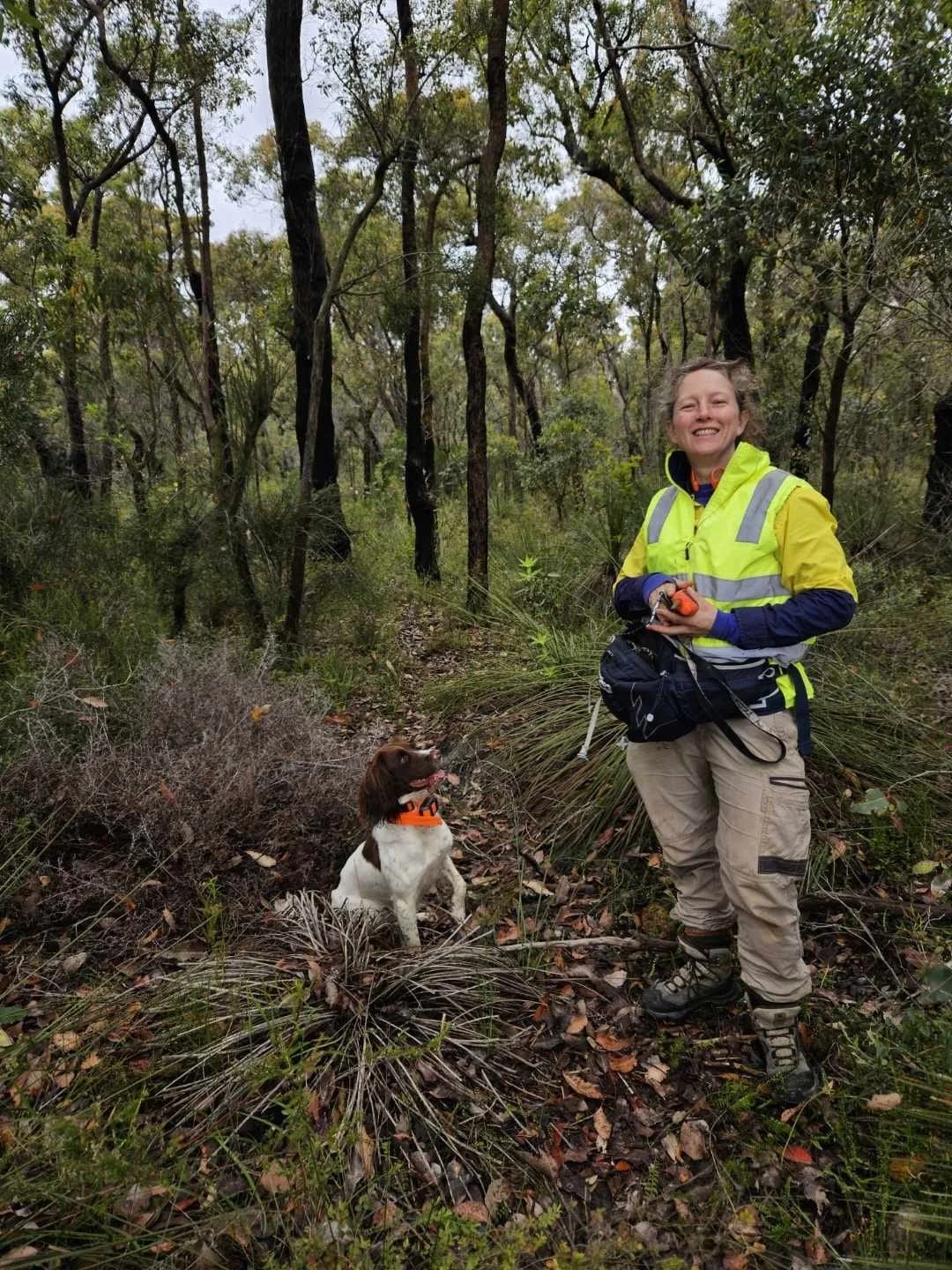
Conservation Detection Dog Work
Conservation detection dogs can sniff out targets impossible for us to find. Whether they are cryptic, tiny, underground or underwater.
What we do
We train and deploy conservation detection dogs for a range of applications. We partner with industry, NGOs, land managers, and the community to support conservation needs. Our dogs work together with their human partners to collect high-quality data. Detection Teams (human + canine) work together as a unit
and are evaluated as a team to ensure they meet both safety and welfare and target identification benchmarks developed in consultation with our partners. Detection teams undertake efficiency evaluations in line with project objectives. Safety and welfare are our highest priority.

The superpowers of detection dogs
A dogs nose combined with the unique relationship of dogs with humans, makes dogs uniquely suited to work together with humans to find things we cannot.
Detection dogs can…
Identify species non-invasively
Find multiple targets simultaneously
Find cryptic, rare and elusive species.
Efficient and cost-effective detection
Learn new target scents rapidly
Scent-sational Conservation:
Specialised ecology and conservation detection services
We conduct research to support threatened species conservation, evaluate the effectiveness and cost-efficiency of using detection dogs, and understand conservation impacts.
As PhD scientists we can supervise students, write grants, conduct high quality analysis and contribute to publication.
Conservation Detection Dog Solutions For Every Need
We offer professional detection dog services for a range of conservation applications
From pests and pathogens to threatened species
-
Detection dog teams are the most effective and efficient method to assess impacts of wind farms on local and migrating bird and bat populations, finding 80% of targets compared to 20% by human only searchers, faster and with less size bias. We offer general bird and bat mortality surveys, but can train to target individual species if desired. Surveys include regular intervals and pulse surveys, and we can also implement scavenger trials for wind farm compliance with environmental regulations, and can support the full cycle of assessment from design to reporting (design, implementation, monitoring). Dogs can also be trained to find and identify carcasses for other applications, such as wildlife crime and biosecurity.
-
From mouse poop to elephant dung, scat is a goldmine of information that can be easily and non-invasively located by conservation detection dog teams and collected!
Using scat scientists can undertake individual, population, and landscape genetic analysis - learning everything from who’s related to who, to where fragmentation is impacting connectivity. Scat can also be incredibly valuable for dietary analysis using a combination of traditional methods and metabarcoding. It can also be used to tell us about stress and reproductive status! Scat detection dogs can target individual species, or multiple species at once!
-
Our dogs lend a paw to conservation by searching for threatened species. We can help with efficiently finding difficult to locate species for survey and monitoring to support survey, monitoring, impact evaluation, and research applications, such as mark recapture, landscape ecology, habitat use studies, and novel applications. Conservation dogs have become recognised internationally as a powerful tool for conservation, among other applications. They have located species thought to be extinct, butterfly eggs and larvae, and diseases. Detection dogs are incredibly valuable for locating rare and cryptic flora, an asset in the incredible biodiversity hotspot we live in. The applications for industry for rapid location of target species are myriad.
-
Invasive species have a huge impact on Australia’s ecosystems, threatening our unique biodiversity. From direct mortality to ecosystem level damage that can cause wholesale collapse, they present a huge risk to Australia’s species and ecosystems.
Conservation detection dogs are particularly useful in early detection, late stage eradication, difficult to find species, and tactical surveillance for invasive insects, plants, and pathogens.
Our dogs can assist with early detection and tactical surveillance - for instance at particularly sensitive sites, speedily locating cryptic invaders to support eradication efforts. Since they use their super sniffers, conservation detection dogs often find visually difficult to locate individuals, such as young, hidden or damaged plants, that volunteers or management staff may miss.
Recent research has shown that in some cases, dogs can be better than existing tests at detecting some pathogens.
Internationally, detection dogs have been used to great effect to find spotted lanternflies, emerald ash borers, and more. Studies show that dogs excel at early detection of larvae, pupae, frass, galleries, and living or dead insects - for instance as part of Emerald Ash Borer control programs.
-
Detection dogs can locate dens and scat of invasive predators. At present we don’t have any trained detection dogs ready for cat and fox work, but we are in the process of building capacity, so if you are interested please let us know so that we can accurately estimate demand and work towards a cost-effective location option.
Didn’t find what you were looking for?
Don’t worry, our dogs can sniff it out! If you didn’t find what you need among our services, don’t hesitate to contact us. We’d love to hear about your custom project and see how we can help.
We offer specialised ecological consulting
Detection For Good offers expert ecological consulting services to clients in both the public and private sectors. Our team of experienced scientists can help you navigate complex environmental regulations, assess and mitigate environmental risks, and develop sustainable solutions to ecological challenges. Contact us today to learn more about our specialised ecological consulting services and how we can support your environmental goals.
Safety & Welfare
At Detection For Good, we prioritise safety and welfare. We are committed to the welfare of our dogs, our people, our clients, visitors and contractors.
Our staff are trained, supervised and instructed to maintain safety.
We provide written instructions, policies, procedures and guidelines to ensure safety
Our dogs are trained to work safely with the handler around wildlife, livestock, people and vehicles.
Our equipment and plant is maintained and inspected regularly
We are compliant with legislative requirements and industry standards
We are aware of and adhere to the highest biosecurity standards
Research Highlights
Discover our
Latest Projects
FAQ
-
Anything we train them to! You can check out our current odours here.
-
That depends on the target, project, similarity of training materials to final target, final context and more. Dogs can learn a new odour in a few hours, and consolidate it in their library best with sessions spread out over a couple of months. The biggest challenges for very rare species can be search strategy, and setting the dog up to succeed in encountering the target. New landscapes and final odours very different to the training material may require in situ training and familiarisation, as each presents a new challenge!!
-
We are currently investigating options to train a cat and fox detection dog, but none of our current dogs are trained on this odour. Should you be interested, get in touch about the timelines and scale of your project, as this will help us plan our future acquisition and training schedule.
-
Nope! Our dogs a trained to have a passive alert - that is, they don’t interact with the target at all. This is usually a down, but may also be a sit or freeze behaviour as needed.
-
There are absolutely ways to be successful with limited options, and we are passionate about making projects work for species in need, but we are going to need material to train the dogs on. More limited material means slower progress.
-
Great question! Yes, with training. If species have similar diets, it is important to train discrimination, as otherwise, the scent may appear similar in the field. For this reason if dogs are trained on samples from captivity, or a different part of the range, there can be a period of adaptive in-field training to clarify target odour.
-
Nope! Dogs can find scat, but they can also find live AND dead targets.
-
Great question! All our dogs are trained to to interact with other wildlife, a skill which is constantly reinforced. All teams dog and human) pass a co-operation and communication assessment to ensure that they can comply with safety standard including responsiveness to safety cues such as emergency stops and recalls in the presence of wildlife and vehicles.





































